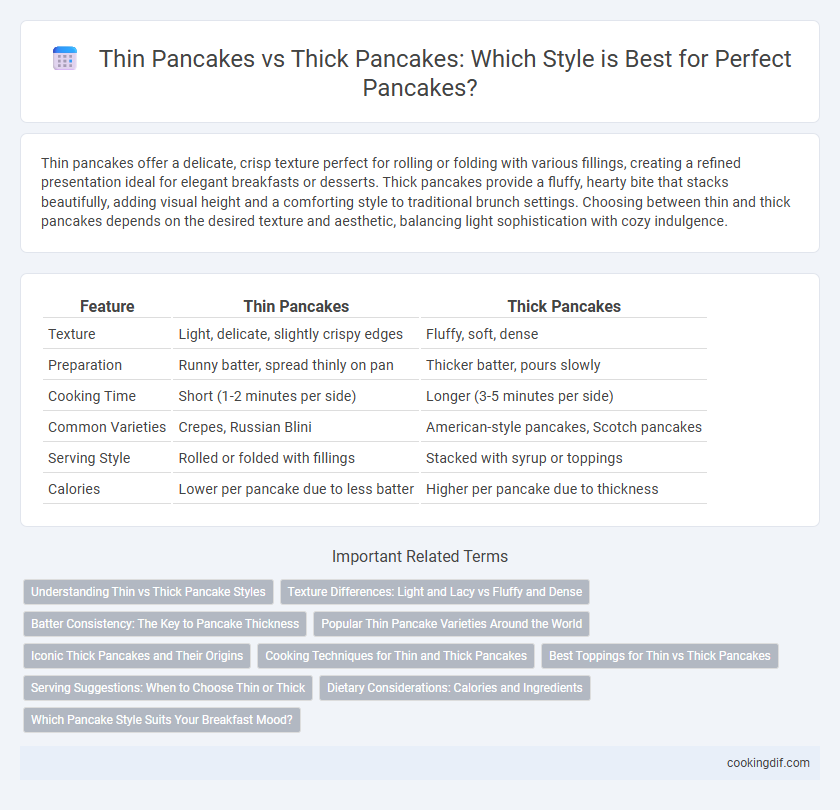Thin pancakes offer a delicate, crisp texture perfect for rolling or folding with various fillings, creating a refined presentation ideal for elegant breakfasts or desserts. Thick pancakes provide a fluffy, hearty bite that stacks beautifully, adding visual height and a comforting style to traditional brunch settings. Choosing between thin and thick pancakes depends on the desired texture and aesthetic, balancing light sophistication with cozy indulgence.
Table of Comparison
| Feature | Thin Pancakes | Thick Pancakes |
|---|---|---|
| Texture | Light, delicate, slightly crispy edges | Fluffy, soft, dense |
| Preparation | Runny batter, spread thinly on pan | Thicker batter, pours slowly |
| Cooking Time | Short (1-2 minutes per side) | Longer (3-5 minutes per side) |
| Common Varieties | Crepes, Russian Blini | American-style pancakes, Scotch pancakes |
| Serving Style | Rolled or folded with fillings | Stacked with syrup or toppings |
| Calories | Lower per pancake due to less batter | Higher per pancake due to thickness |
Understanding Thin vs Thick Pancake Styles
Thin pancakes, such as crepes, offer a delicate texture and flexibility ideal for rolling or folding with sweet or savory fillings. Thick pancakes feature a fluffier, spongier consistency, making them perfect for stacking and absorbing syrup or butter. Understanding the differences in batter composition, cooking time, and technique helps achieve the desired pancake thickness and style.
Texture Differences: Light and Lacy vs Fluffy and Dense
Thin pancakes boast a light and lacy texture with delicate edges that crisp up nicely, making them ideal for folding or rolling with fillings. Thick pancakes feature a fluffy and dense interior, offering a soft and pillowy bite that holds syrup and toppings well. Texture differences stem from batter consistency and cooking method, influencing the overall eating experience and preferred style.
Batter Consistency: The Key to Pancake Thickness
Batter consistency is the key factor determining pancake thickness, with thinner batters producing delicate, thin pancakes and thicker batters yielding fluffy, thick pancakes. Adjusting the ratio of liquid to flour allows control over the pancake's texture and style, as thin batters spread quickly on the griddle while thick batters hold their shape for a fluffier bite. For thin pancakes, a pourable, smooth batter with higher liquid content is ideal, whereas thick pancakes require a denser, less fluid batter to achieve the characteristic puffiness.
Popular Thin Pancake Varieties Around the World
Thin pancakes, such as French crepes, Russian blini, and Italian crespelle, are celebrated globally for their delicate texture and versatility in both sweet and savory dishes. These varieties often feature a paper-thin consistency that allows for intricate folding or rolling, enhancing presentation and flavor absorption. Their popularity in international cuisines highlights the cultural appreciation for light, easily adaptable pancakes over the denser, fluffier American-style thick pancakes.
Iconic Thick Pancakes and Their Origins
Iconic thick pancakes, often associated with American breakfast traditions, boast a fluffy texture achieved by using leavening agents like baking powder. Unlike thin pancakes, such as French crepes, thick pancakes prioritize a soft, airy interior that complements hearty toppings like maple syrup and butter. Their origins trace back to early European settlers who adapted recipes to local ingredients, creating the signature stack enjoyed today.
Cooking Techniques for Thin and Thick Pancakes
Thin pancakes require a batter with a higher milk-to-flour ratio, allowing for easy spreading and quick cooking on a hot griddle to achieve a delicate, lacy texture. Thick pancakes use a thicker batter, often with added leavening agents like baking powder, and require lower heat with a longer cooking time to ensure a fluffy, tender interior without burning the surface. Mastering temperature control and batter consistency is essential for perfecting the contrasting textures of thin and thick pancakes.
Best Toppings for Thin vs Thick Pancakes
Thin pancakes boast a delicate texture that pairs exceptionally well with light toppings such as fresh berries, lemon zest, and a drizzle of maple syrup, enhancing their subtle flavor without overpowering it. Thick pancakes offer a heartier base suitable for richer toppings like whipped cream, chocolate chips, and fruit compotes, providing a more indulgent eating experience. Selecting toppings that complement the pancake thickness enhances the overall taste and texture, making each style uniquely satisfying.
Serving Suggestions: When to Choose Thin or Thick
Thin pancakes offer a delicate texture perfect for rolling or folding with sweet spreads like honey, lemon juice, or fresh fruit, making them ideal for light breakfast or dessert presentations. Thick pancakes provide a fluffy, hearty base that holds syrup, butter, or savory toppings well, suited for substantial brunch servings or meals requiring more filling consistency. Choose thin pancakes for elegant, refined dishes and thick pancakes when a comforting, dense texture enhances the overall dining experience.
Dietary Considerations: Calories and Ingredients
Thin pancakes typically contain fewer calories due to their reduced batter thickness and often use lighter ingredients, making them a preferred choice for calorie-conscious diets. Thick pancakes, while more filling and rich in texture, generally have higher calorie counts because of added ingredients like butter, milk, and sugar to achieve their dense consistency. Opting for whole-grain flour or alternative flours in either style can significantly impact nutrient content and dietary benefits.
Which Pancake Style Suits Your Breakfast Mood?
Thin pancakes offer a delicate texture and subtle flavor ideal for light breakfasts or when paired with fruity toppings, while thick pancakes provide a hearty, fluffy bite perfect for those craving a filling and indulgent start to the day. Choosing between crepes or American-style flapjacks depends on whether you prefer a versatile base for sweet or savory dishes or a substantial stack that can support rich syrups and butter. Your breakfast mood ultimately guides the choice: a crisp, elegant thin pancake for a refined meal or a thick, satisfying pancake for a comfort food experience.
Thin pancakes vs thick pancakes for style Infographic

 cookingdif.com
cookingdif.com